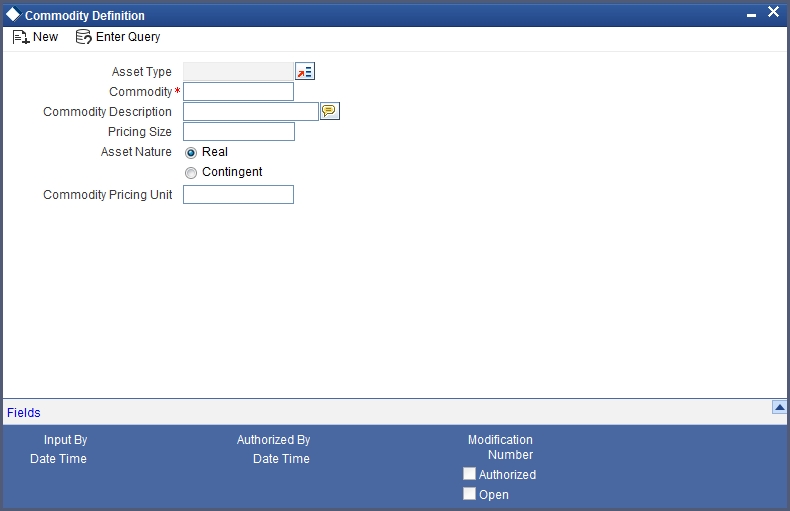3. Underlying Asset Definition
Derivatives are contracts, which convey the right/obligation to buy or sell a specified asset at a specified price at a specified future date. An underlying asset (or also called Commodity) of the derivative contract is the one that is to be bought or sold on a future date. Existing currencies within Oracle FLEXCUBE can be identified as underlying assets. For example U S Dollar (USD), which is recognized as a currency in Oracle FLEXCUBE, would be the underlying asset for a US Dollar option. Similarly, Equities, Bonds and Zero Coupon bonds can also be defined as underlying assets.
This chapter details the procedures for defining Commodities (or Underlying Assets) in Oracle FLEXCUBE.
This chapter contains the following sections:
3.1 Underlying Asset Definition
This section contains the following topic:
3.1.1 Invoking Underlying Asset Definition Screen
In Oracle FLEXCUBE, the underlying assets or commodities can be categorized and maintained through the ‘Underlying Asset Definition’ screen.
You can invoke this screen by typing ‘EDDCOMDF’ in the field at the top right corner of the Application tool bar and clicking on the adjoining arrow button

To enter new records in this screen, click new icon. You can specify the following details in the screen.
Underlying Asset
Specify a name for the underlying asset here. This name that you give to a underlying asset identifies the underlying asset throughout the module. Ensure that the name assigned to the underlying asset is unique and is not used to identify any underlying asset commodity/asset. This is a mandatory field.
You can follow your convention for naming the commodity. However, the name should not exceed 16 characters.
Underlying Asset Description
You may provide additional details of the underlying asset here. Your description for the underlying asset can be in no more than 255 characters. This description is associated with the underlying asset for information retrieval purposes only.
Asset Type
Specify the Asset Type under which your asset should be grouped. Although you can define as many asset types as required, a list of pre-defined asset types is available in Oracle FLEXCUBE. This list includes:
- Bond
- Commodity
- Currency
- Derivatives
- Equity
- Index
- Interest rates
Select the appropriate asset type from the adjoining list of options.
Note
Individual underlying asset can be mapped to any one of the above asset types. However, while defining currency assets (like U S Dollar, Great British Pound, Japanese Yen, to name a few) you have to strictly map them to the Asset Type – Currency. Similarly while defining indices (like the BSE Sensex, NYSE, LSE etc) it is mandatory that you map them to the Asset Type – Index.
For example, while maintaining USD (U.S Dollar) as a commodity, you must group it under the Asset type – Currency. Similarly if you create a commodity titled – BSESENSEX, it should be grouped under the asset type – INDEX.
Nature of Asset
Specify the nature of the asset under which the underlying asset is categorized. This indicates the basic nature of the underlying asset. The options available are:
- Real
- Contingent
Indicate whether the nature of the underlying asset is ‘Real’ or ‘Contingent’ depending on the physical holding of the underlying. Let us assume that you are identifying a particular currency in Oracle FLEXCUBE as an underlying asset. In this case the nature of the asset will be ‘Real’. However, if you are maintaining an option on a currency swap as an underlying asset, the underlying asset or commodity is not the currency but the currency swap itself. Therefore the underlying asset becomes a contingent asset.
Pricing Size and Underlying Pricing Unit
You can indicate how the underlying asset is priced in the market by specifying the market price per unit of the underlying. Since every instrument that is processed in the system automatically inherits the characteristics of the underlying asset, the pricing size and the unit will be defaulted to the Instrument.
For instance, let us assume you are maintaining the currency DEM (Deutsche Mark) as a underlying asset in Oracle FLEXCUBE. If DEM is quoted in the market in terms of 1 DEM, then the Pricing Size and the Pricing Size Unit that you specify will be as follows:
| Field | Value | ||
|---|---|---|---|
| Pricing Size | 1 | ||
| Pricing Size Unit | DEM |
Similarly, if you are capturing the details of the commodity titled Crude Oil and Crude Oil is quoted in the Market in terms of 1 barrel, your entries in the respective fields will be:
| Field | Value | ||
|---|---|---|---|
| Pricing Size | 1 | ||
| Pricing Size Unit | Barrel |
Examples of how to define an underlying asset in Oracle FLEXCUBE
Let us assume you want to define the following underlyings:
- DEM (Deutsche Mark)
- Crude Oil
While maintaining the details of each underlying your entries in Oracle FLEXCUBE will have to be as follows:
Scenario 1 – DEM
| Field | Value | ||
|---|---|---|---|
| Underlying Asset | DEM | ||
| Asset Type | CURRENCY | ||
| Nature of Asset | Real | ||
| Pricing Size | 1 | ||
| Pricing Size Unit | DEM |
Scenario 2 - Crude OIL
| Field | Value | ||
|---|---|---|---|
| Commodity | CRUDE | ||
| Asset Type | FUEL | ||
| Asset Nature | Real | ||
| Pricing Size | 1 | ||
| Pricing Size Unit | Barrel |